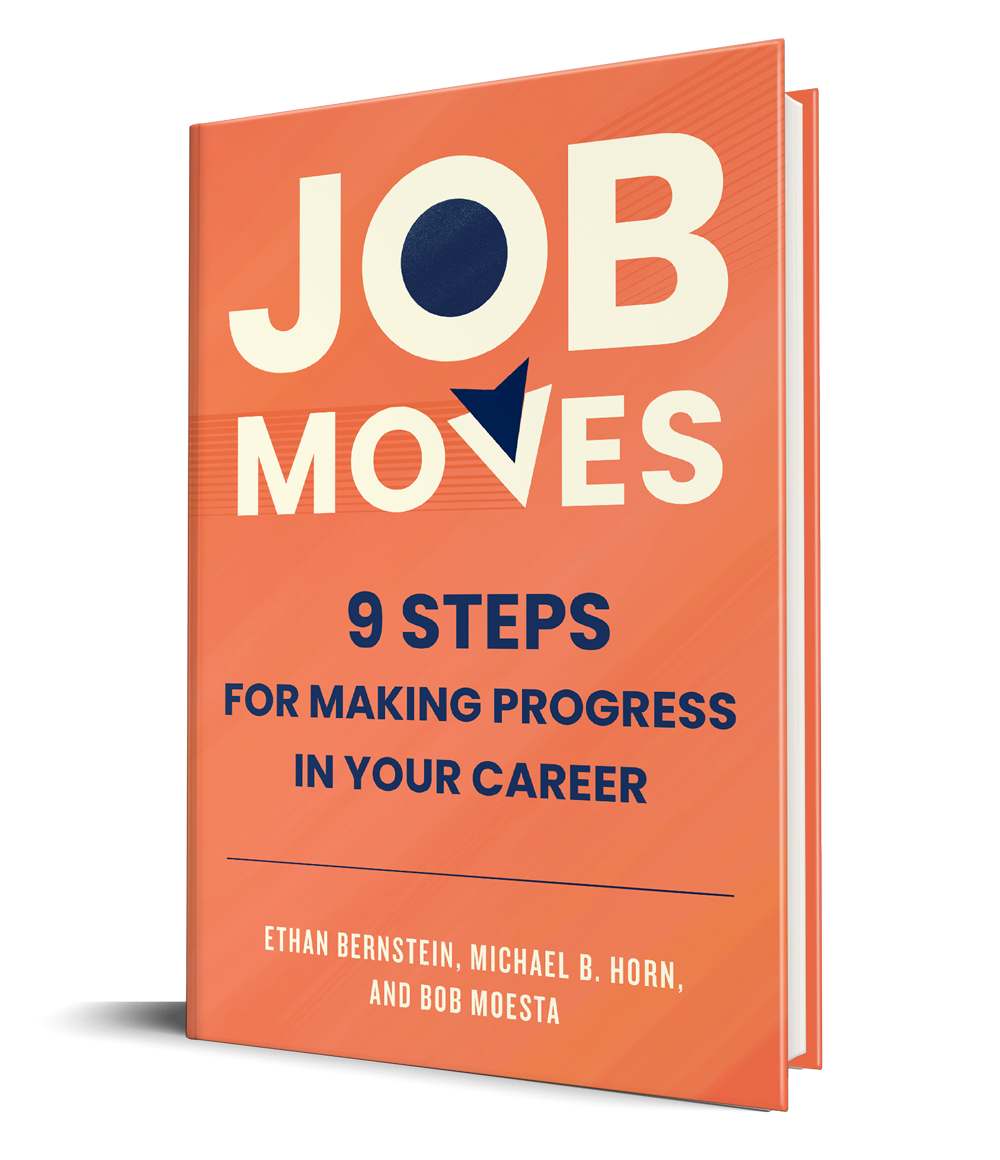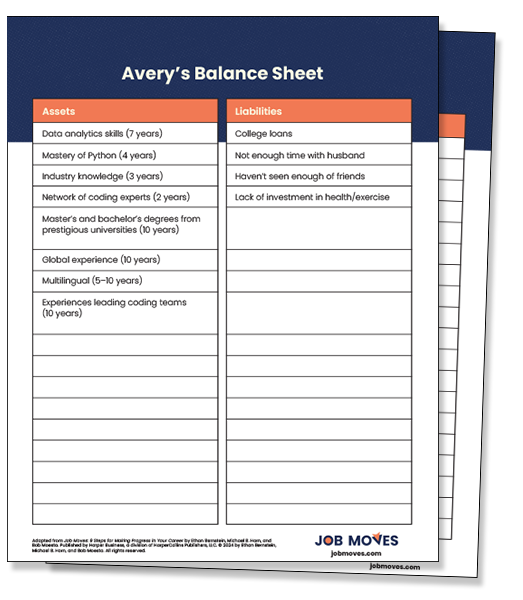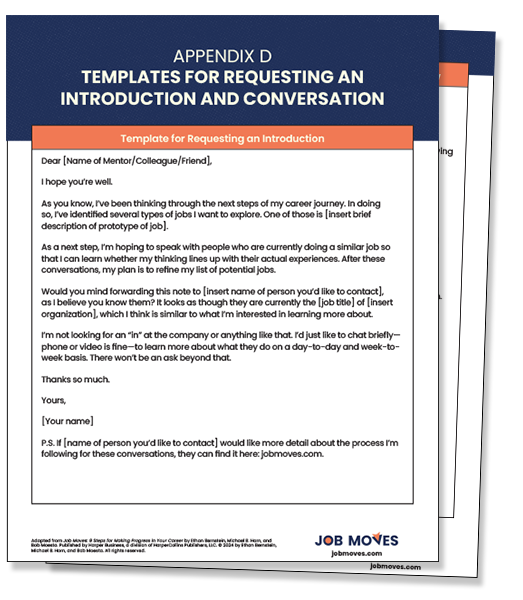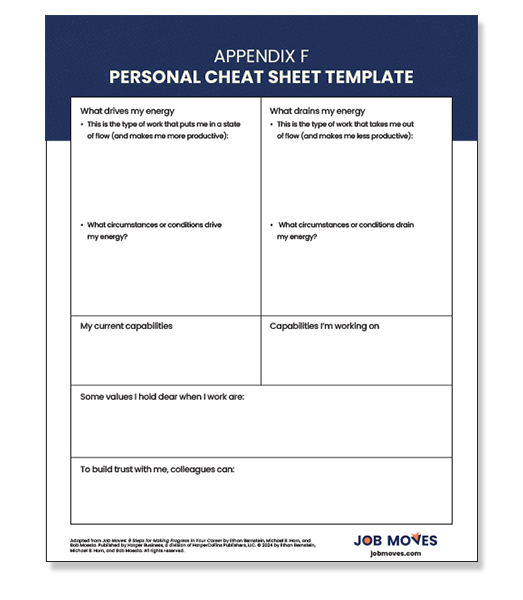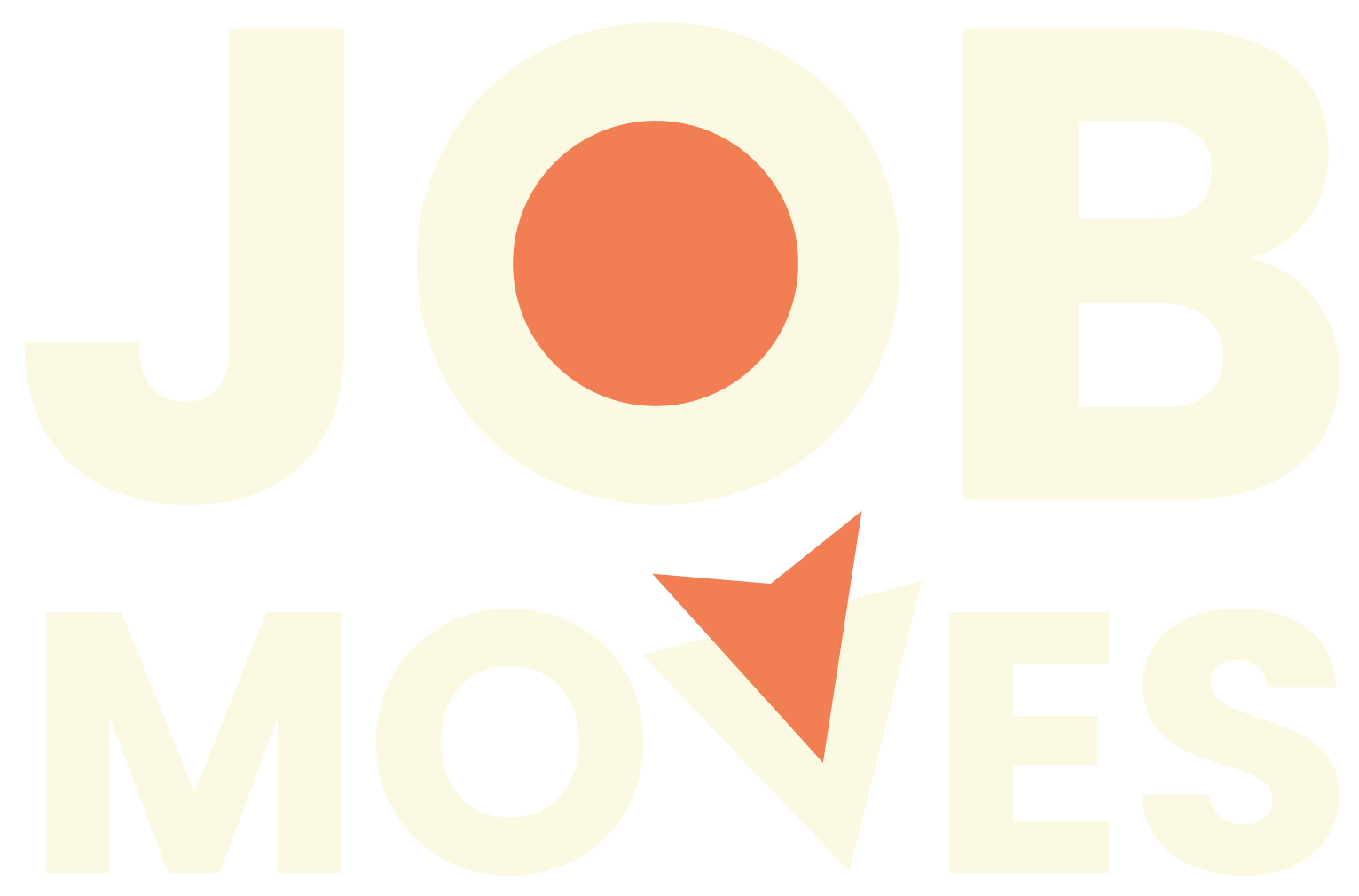Resources
Quick Links:
The Job Moves Assessment
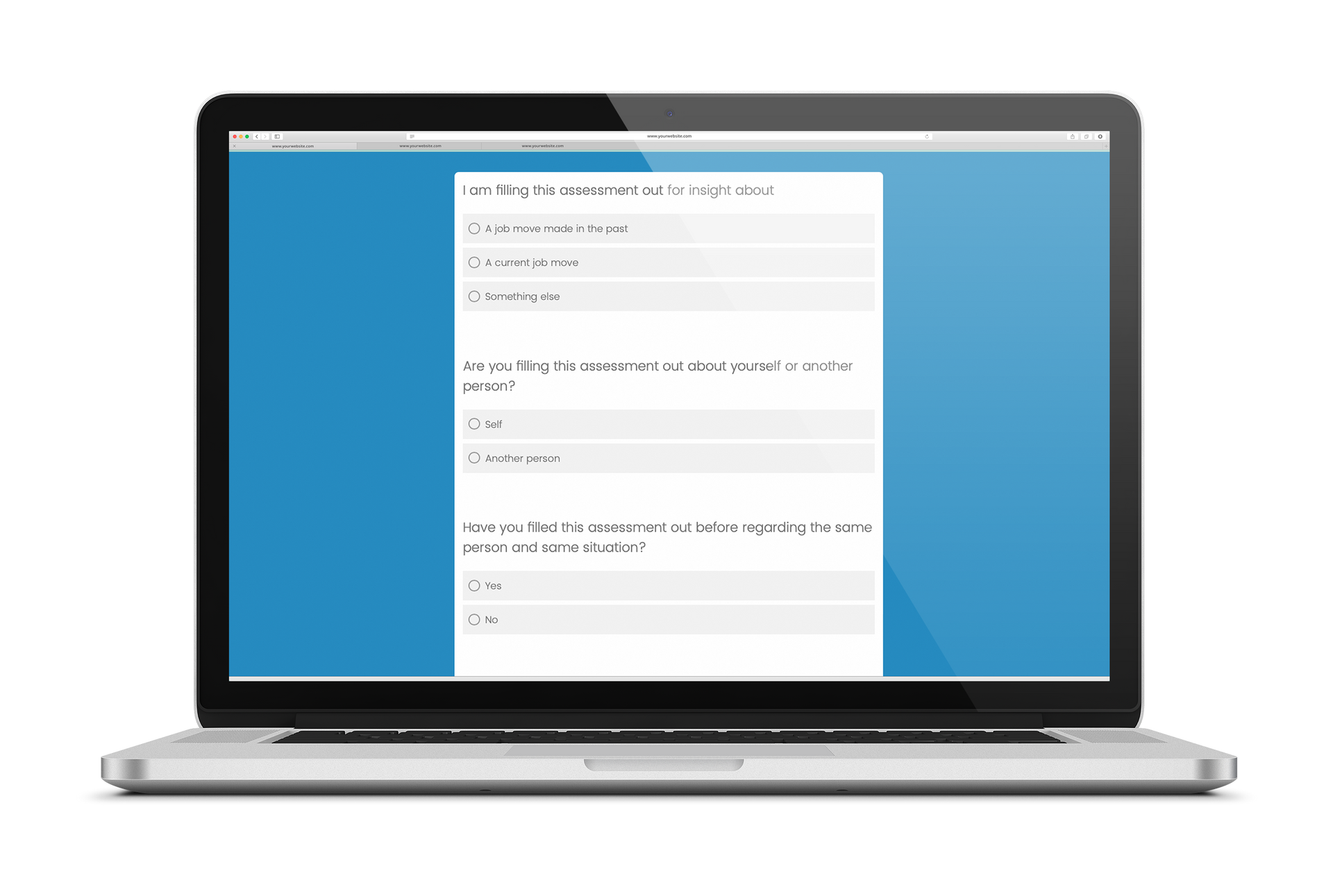
Across the thousands of careers we’ve studied, we’ve seen four consistent patterns at play that cause people to make a job move. We call these patterns "quests for progress." The four quests are to Get Out, Regain Control, Regain Alignment and Take the Next Step. You can learn more about each quest in the book.
Although each person’s path is unique in its own way, we've built a tool to help you see which quest you were most likely on when you switched jobs in the past—AND to help you figure out which quest is likely motivating you to look for something new now. Knowing that makes it far more likely you will make a good job move—as opposed to one you'll regret within a few months and find yourself looking for a new job... yet again. What's more, the assessment will take you less than 10 minutes!
Career Balance Sheets
To see your current capabilities more concretely—and understand the investments they require—it’s useful to think in terms of professional assets and liabilities and create your own career balance sheet.
From years of running this exercise with thousands of job switchers, we’ve found that it’s useful to list eight to twelve assets and eight to twelve liabilities. You needn’t generate precisely the same number of each. Instead, focus on doing a true accounting of what matters. When creating balance sheets for organizations, accountants determine which items are “material” and omit things that don’t clear that bar. The same principle applies here. Just get the big picture right so you can decide what types of roles and organizations would best suit you at this stage of your career.
Once you have drafted your lists, estimate the useful life of each asset and be context specific. Be brutally honest with yourself about depreciation. The idea of this balance sheet is to start to make the trade-offs clear. You want a realistic picture of what’s required to maintain, build, or develop an asset for your career trajectory.
After you’ve taken a first pass at your balance sheet, ask a mentor to do a congenial audit. What assets and liabilities would they include if they were you? Does your list line up with theirs? Individuals are often prone to overestimating or underestimating their capabilities. A reality check from someone who is willing to be honest is helpful. Also see if they agree with your useful life estimate for each asset. Perhaps you’ve been too generous with how long assets will remain relevant and how many of them are evergreen?
This conversation should further clarify the trade-offs you’ve made to get where you are now and present a clear-eyed and accurate view of your current assets. That will be critical when you start to build out possibilities for what you could do next.
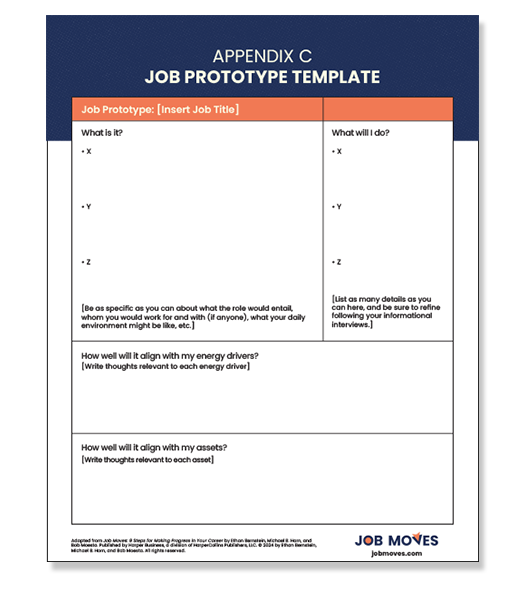
Job Prototype Template
With your quest identified, you’re ready to use all the information you’ve gathered so far in our process to imagine a wide range of possibilities for what you could do next. This step, creating prototypes for your next move, takes advantage of what designers call divergent thinking. The goal is to create contrasting visions of your future. By doing so, you’ll deepen your understanding of what would be a good choice for you at this stage of your career and learn before switching what each of these options that sound appealing actually entails.
Brainstorm a list of jobs that might deliver your critical “must-haves.” Those will be your early prototypes. This work will likely take some dedicated time over several days or a couple weeks. If you were already offered a new job—perhaps that’s what pulled you into this job-switching process—then include that role as one of your prototypes. Once you have sketched out several options, you must flesh them out to create true prototypes that can be tested against the things that matter most to you. To help build out each one, use this template here.
Prototype Interview
You’ve done some good brainstorming. Now let’s see how accurate your early prototypes are. To check, you’ll line up informational interviews with people in jobs like the ones you’ve mocked up. Chances are you’ll be having these conversations anyway as you “network” to learn about jobs and gain access to new opportunities. But we provide a structure for the “asks” and for the conversations themselves—which can make this part of the process feel less daunting. From personal experience, we know these asks can be difficult. To make them easier, we’ve use these letter templates here that you can modify to fit your circumstances.
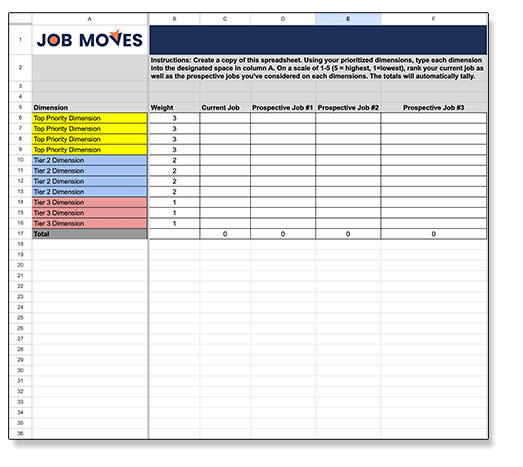
Rank Your Prototypes Spreadsheet
Just as you force ranked past jobs on each energy driver—on a continuum between “not present at all” and “fully present”—you’ll use that same scale to rank your prototypes on each energy driver and asset here. In the process, you might discover you don’t yet have enough information to rank things accurately. That’s okay. When this happens, it just means you need to flesh out your prototypes a bit more. You could do another informational interview or two to fill in what you don’t know, for example, or huddle with thought partners to reanalyze the data you’ve gathered. At least you’ve identified that gap in knowledge before taking a new job. That’s a critical part of learning before switching.
People ask us if they should rank all their prototypes, even those they’ve mentally eliminated from serious consideration in the course of their informational interviews. We recommend ranking everything. That’s because it further clarifies your understanding of what your priorities are and why. The greater the contrasts between your prototypes, the deeper your insights will be around what’s driving you right now. In other words, the process of converging from a handful of prototypes to just one or two isn’t “wasteful.” It’s how you’ll learn. More wasteful is skipping straight to “the answer” that isn’t the actual answer at all.
We encourage you to include your current job in the prototype rankings as well because it’s something you could continue to do if you decided it would be better than pursuing other pathways. Ranking all your prototypes also puts a finer point on how willing you are to make certain trade-offs
to get different jobs.
Finally, this part of the process builds a bridge between what caused you to switch jobs in the past and what will motivate you to switch in the future, because you’ll now be able to see how both your past roles and your prototypes stack up on the energy drivers and assets that matter to you. As we mentioned earlier, the things people care about shift over time. This can happen slowly or suddenly. Either way, our process allows for that movement.
Such shifts will come through in your rankings of past and potential roles. Whatever your situation, once you’ve ranked your prototypes on each of your energy drivers and assets, one or two roles should rise above the rest. In most cases, those front-runners confirm one’s quest. That’s because the prototypes we design and gravitate toward reveal important information about the progress we’re seeking.
To force rank your prototypes on each of the energy drivers and assets you’ve prioritized, you can use our spreadsheet here, which will do the math for you.
Personal Cheat Sheet
A personal cheat sheet is a quick guide that details the best way to work with you. In the same way that the latest gadget on the market comes with a one-page reference sheet to help people get started quickly and productively, a personal cheat sheet sums up how others can get the most out of you—so that you’re all successful.
There’s no set format for the personal cheat sheet. Just do what feels authentic to you, and make it concise—no longer than one page or screen. Feel free to get creative as you do this exercise.
Here is an adapted template that we like to use with our mentees, along with examples of personal cheat sheets from people we’ve coached.

